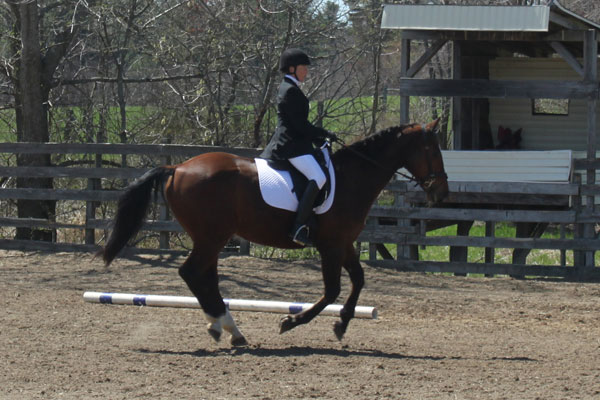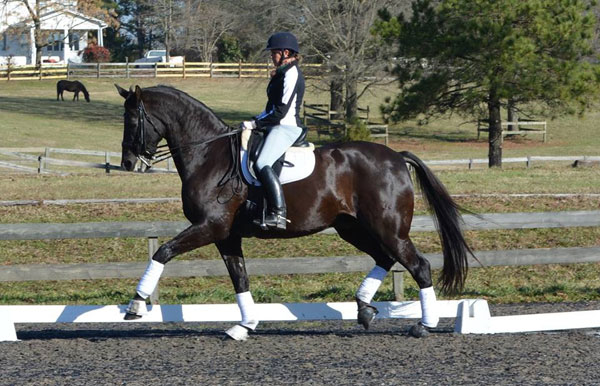Rider 1—Proper Leg Position

This photo shows Marlene Morin riding Litigator, a 19-year-old Dutch Warmblood schoolmaster. Marlene shows a very nice ability to find the correct balance for her upperbody, and she appears to sit naturally upright. I notice that she has some difficulty relaxing her leg. The knee appears to be sliding up a bit and her lower leg is turned so that her toes point outward. This often happens when the rider is trying to use the inside lower leg to encourage the horse to move forward. To improve her leg position, Marlene needs to first connect deeper with her seat. As Gustav von Dreyhausen’s “circle of aids” dictates: first seat, second leg, last hand.
Try this: With your seat bones weighted equally in the saddle, try closing your legs—alternate the inside or outside leg more, then try both together. Check that your seat bones stay in touch with the saddle as you are doing this. Using your deep abdominal muscles and stretching your chest and head a little upward can help you to stay connected longer when closing your legs on your horse.
The amount of strength in our adductor muscles is not important in dressage. It is more about the balance and coordination between our aids. The better a rider can use her lower tummy muscles and control her pelvis, the more she can close her legs without losing or changing the contact of her seat bones. Just as any taking of the reins must be followed by yielding of the hands, any closing of the leg must be followed by a release. The quality of the leg aid is more about how quickly you can relax than how strongly you can close. Coordination between the pelvis and legs, coupled with good timing—giving the leg aid with the horse’s rhythm—is the secret to a supple leg that can whisper and breathe.
Marlene’s habit of turning her toes out can be a result of a misunderstanding of how to use her lower leg. The main function of the knee is to bend and stretch the leg. In the bent position, the knee can rotate in and out slightly. But it is impossible to move the lower leg sideways in or out from the knee. Thus, turning the toes outward allows us to get more contact between the lower leg and the horse’s side. But this shortens the leg, leads to unwanted tension and does not give the horse the correct aid. To achieve more contact with the lower leg, the upper leg needs to open and allow the movement to start from the hip. The rider should feel that as the hip angle widens, the lower leg feels more contact just below the knee. This allows the seat bones to stay connected to the saddle while the leg makes more contact.
Rider 2—Fixing Negative Tension
This photo of Leslie Bean and her 1998 Oldenburg gelding, Apollinaire, shows powerful movement with good lift of his legs and a collected, elevated frame. The rider’s seat shows experience, and her leg position is textbook.

I hope this was only the case at the moment this photo was taken, but I must mention it: The horse’s mouth is wide open, with the curb bit angled too much. Zooming in, I cannot see his tongue, which indicates that he has pulled it up. This leads to unwanted tension in his jaw and in the first two joints of his neck. Maintaining a soft inside flexion and lightness during transitions is difficult when the tongue is pulled up. Without a relaxed jaw and tongue, correct suppleness cannot be achieved.
The horse’s tongue has a connection to his breastbone. If the horse is tense in the lower neck muscles, he often cannot relax his tongue. The open mouth with the pulled-up tongue may be connected to this tension in his neck muscles. Finding the correct balance of how much collection can be achieved without losing suppleness is an art and must be developed anew in every ride.
I notice a disproportionately higher lift in Apollinaire’s front leg than in his hind. I would advise Leslie to ride in a slightly lower frame to allow his back to round more and let the movement start more from his hind legs. Only when his back is up can his neck be carried higher.
Try this: Place your fingers on the back of your neck. Drop your head down and feel the vertebrae of your neck sticking out. The lowest one of the neck (C7) is the easiest to feel, as it sticks out the farthest. As you lift your head, feel that this seventh vertebra stays in place, as it is connected to the ribs and has more stability. You can feel the vertebra above (C6) slide forward because it is the first relatively free and mobile vertebra above the thoracic spine.
Now lift your head while pressing your C6 vertebra backward against your fingers. You will feel that you need to use your abdominal muscles and lift your chest to do this. This provides important stability for the rider’s upper body, and it is true for the horse as well. The hollowness between the sixth and seventh vertebrae of the horse’s neck is even bigger than that of a person. This means that the horse, when being ridden in a more collected frame and with a higher neck position, must use his abdominal muscles to provide stability as well as the ability to lift his back.
Susanne von Dietze is a leader in equestrian biomechanics. A physiotherapist, licensed Trainer A instructor and judge for dressage and show jumping, she gives lectures and seminars throughout the world, including at the prestigious German Riding Academy in Warendorf. She is a native of Germany and now lives with her husband and three children in Israel, where she competes at the international level. She is the author of two books on the biomechanics of riding: Balance in Movement and Horse and Rider, Back to Back. Find her books at HorseBooksEtc.com.
Send Your Photo!
You can submit your high-resolution dressage photo for critique (300 dpi and 4 by 6 inches in size). Or you can send your photo with a link to a short video. Email to [email protected]. Turnout in dressage show or clinic-appropriate attire is encouraged. Don’t forget your helmet!











